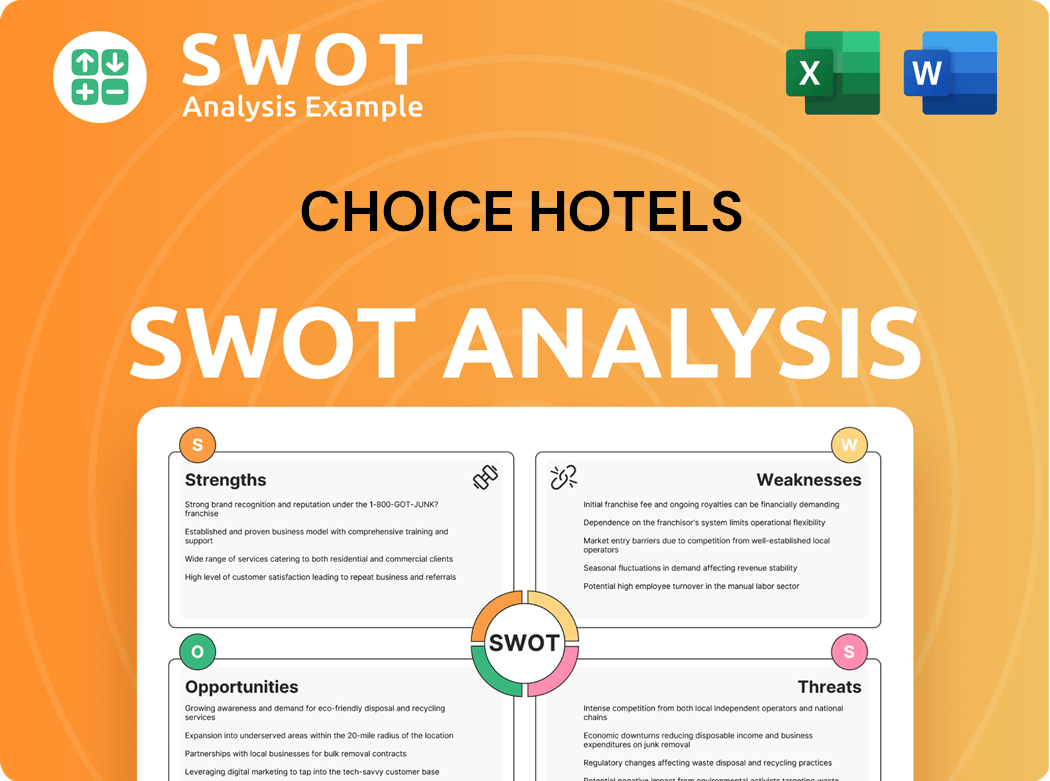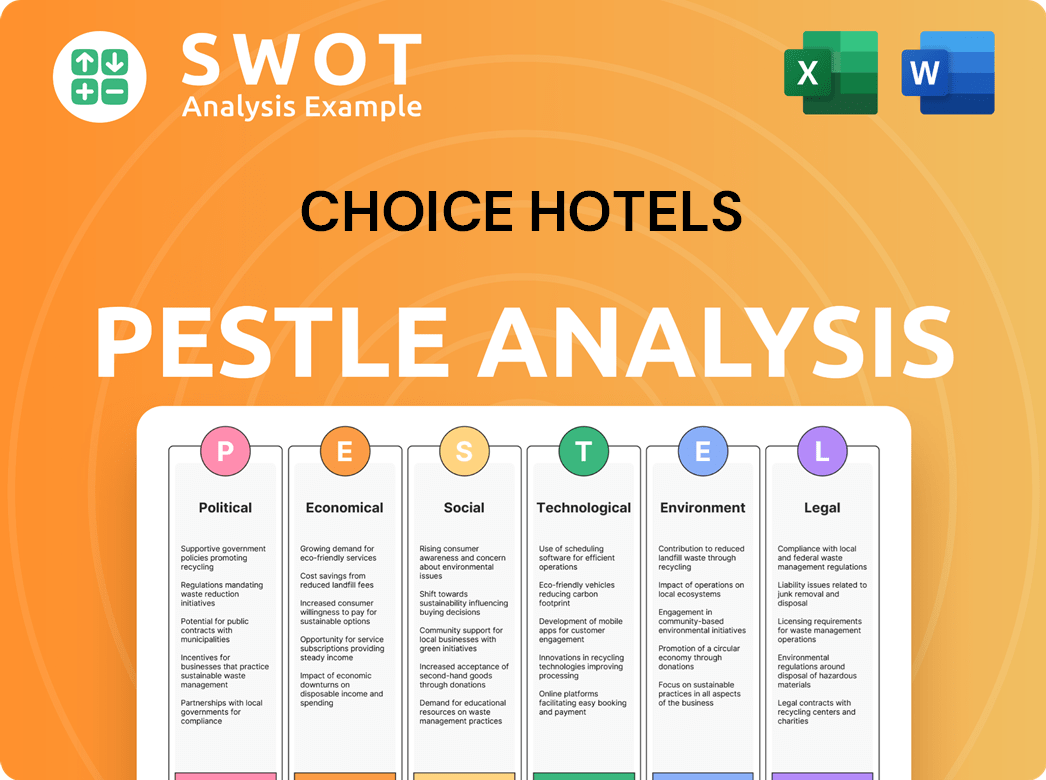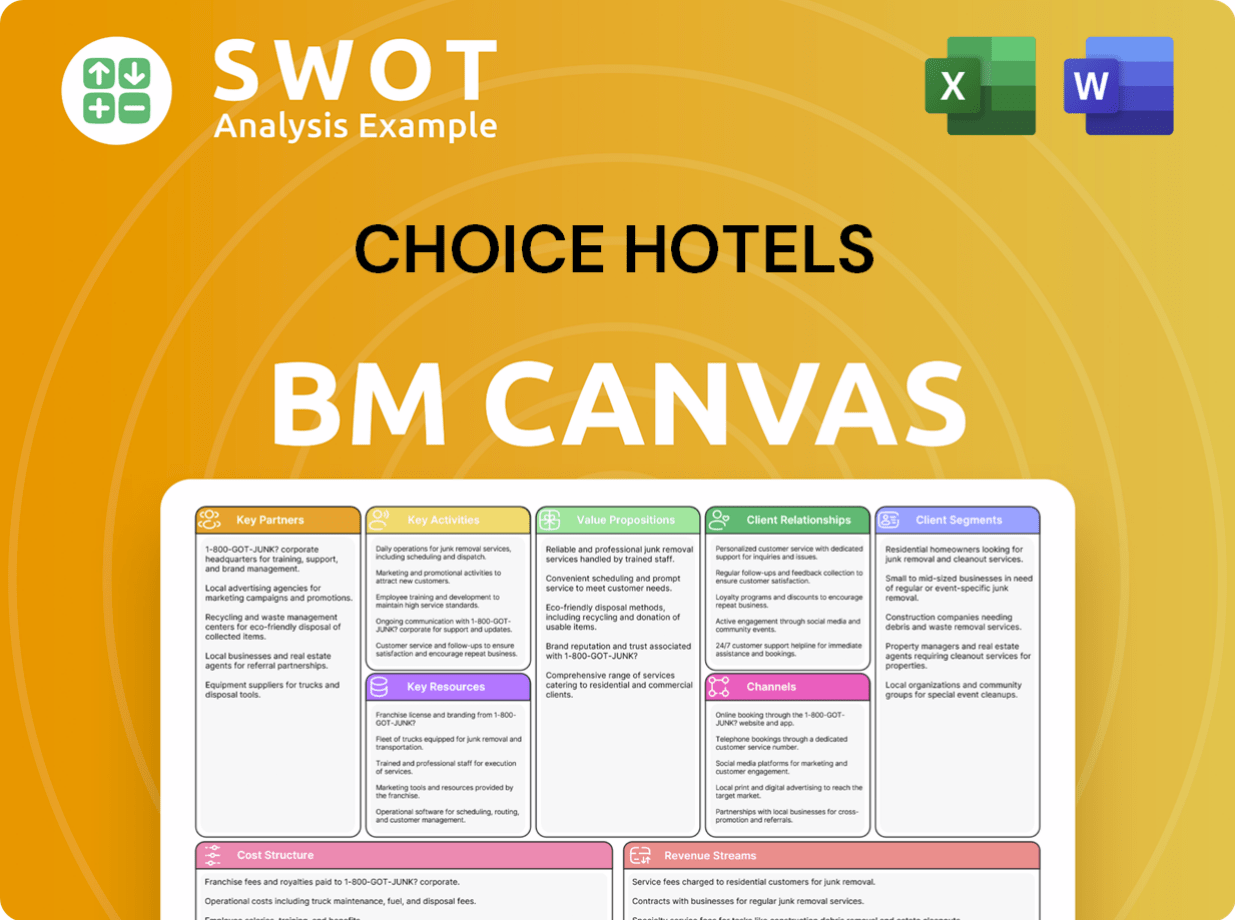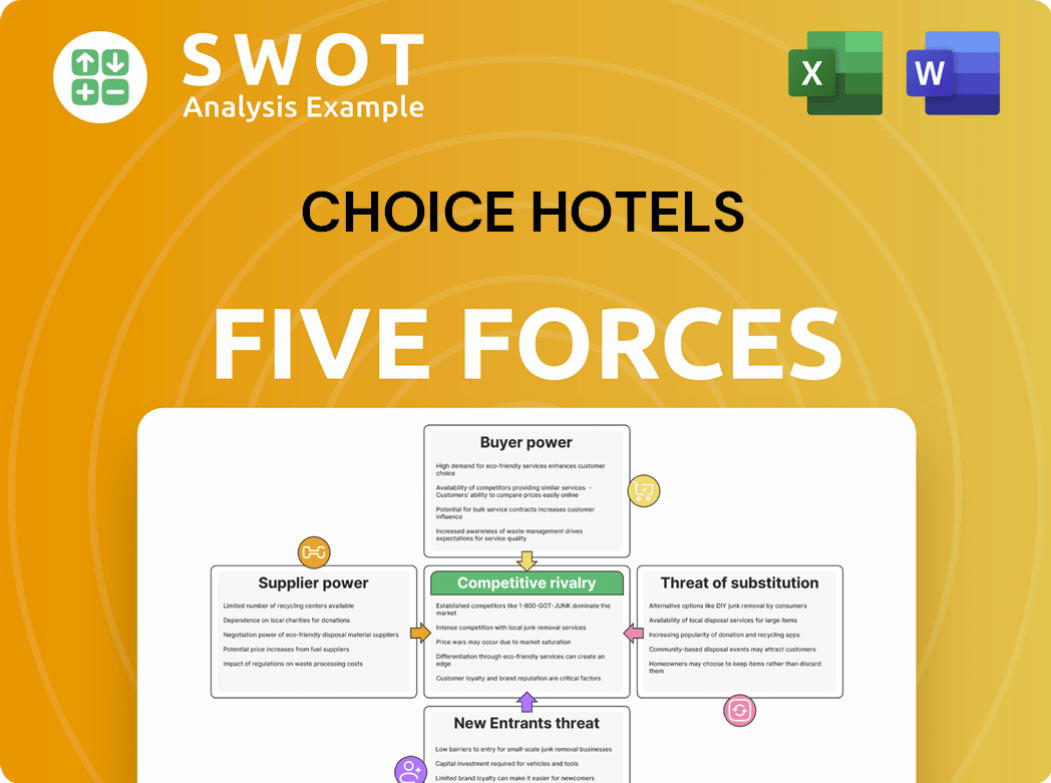Choice Hotels Bundle
How Does Choice Hotels Stack Up in Today's Hotel Wars?
The hotel industry is a battlefield, constantly reshaped by consumer demands and technological leaps. Choice Hotels International, a global lodging franchisor, has carved a significant niche for itself. From its Quality Courts origins in 1939, the company has expanded to a diverse portfolio. This evolution demands a close look at its competitive standing.

To truly understand Choice Hotels' success, we must dive into its Choice Hotels SWOT Analysis, explore its market position, and dissect its key rivals. This deep dive into the Choice Hotels competitive landscape will reveal its unique advantages, how it tackles industry trends, and the challenges it faces. We'll also analyze the company's franchise model competition and its impact on the hospitality market share.
Where Does Choice Hotels’ Stand in the Current Market?
Choice Hotels International strategically positions itself as a leading franchisor within the global lodging industry. As of early 2024, the company boasted a substantial presence with approximately 7,500 hotels, representing nearly 630,000 rooms across 46 countries and territories. This extensive network underscores its significant global footprint and operational scale, a key factor in the competitive landscape.
The company's portfolio is diversified, encompassing various segments from economy brands like Quality Inn to upscale options such as Cambria Hotels. This diverse brand structure allows Choice Hotels to cater to a broad spectrum of travelers and market demands. The franchise model enables rapid expansion and market penetration, which is crucial for maintaining and growing its market position in the competitive hospitality market.
Choice Hotels' success is evident in its financial performance. For the first quarter of 2024, Choice Hotels reported a 5.7% increase in total revenues, reaching $316.5 million. Additionally, the domestic RevPAR (Revenue Per Available Room) increased by 2.7% during the same period, demonstrating its ability to drive revenue growth. The adjusted EBITDA also increased by 10% to $128.5 million, highlighting its strong financial health and operational efficiency. Understanding the Revenue Streams & Business Model of Choice Hotels is crucial to comprehending its market position.
Choice Hotels holds a substantial market share, particularly in the economy and midscale segments. This strong presence allows the company to effectively compete with other major players in the hotel industry competition. The company's focus on these segments provides a solid base for sustained growth and profitability.
With a presence in 46 countries and territories, Choice Hotels has a significant global footprint. This extensive geographic reach allows the company to diversify its revenue streams and mitigate risks associated with regional economic fluctuations. Its international presence is a key factor in its competitive landscape.
In Q1 2024, Choice Hotels demonstrated robust financial performance, with a 5.7% increase in total revenues to $316.5 million. The company's ability to maintain and grow revenues indicates a strong competitive position. The increase in adjusted EBITDA by 10% to $128.5 million further strengthens its market position.
The franchise-centric model allows Choice Hotels to expand rapidly and efficiently. This model reduces capital expenditure and operational risk, enabling the company to focus on brand management and strategic growth. This approach is a key element of its competitive advantages and disadvantages.
Choice Hotels' competitive advantages include a strong brand portfolio, a robust franchise model, and a focus on the economy and midscale segments. These factors contribute to its ability to maintain a solid market position and compete effectively against rivals.
- Extensive Brand Portfolio: A diverse range of brands caters to various traveler segments.
- Franchise Model: Enables rapid expansion and reduces operational risks.
- Strong Financial Performance: Consistent revenue growth and profitability.
- Geographic Diversity: Operations in 46 countries and territories.
Choice Hotels SWOT Analysis
- Complete SWOT Breakdown
- Fully Customizable
- Editable in Excel & Word
- Professional Formatting
- Investor-Ready Format

Who Are the Main Competitors Challenging Choice Hotels?
The Choice Hotels competitive landscape is characterized by a diverse set of rivals, spanning global hotel chains, independent operators, and emerging accommodation platforms. Understanding these competitors is crucial for a comprehensive Choice Hotels market analysis and assessing its strategic position. The hotel industry competition is intense, requiring continuous adaptation and innovation.
Choice Hotels competitors include both direct and indirect players. Direct competitors offer similar services and target the same customer segments. Indirect competitors, such as online travel agencies (OTAs) and alternative accommodation providers, influence market dynamics through pricing, distribution, and customer preferences.
Choice Hotels' ability to navigate this competitive environment depends on its strategic initiatives, brand strength, and operational efficiency. For a deeper understanding of their target audience, consider exploring the Target Market of Choice Hotels.
Wyndham Hotels & Resorts is a significant direct competitor, particularly in the economy and midscale segments. It operates a franchise-centric model with brands like Days Inn and Super 8. Wyndham's competitive strategy often involves aggressive pricing and broad market penetration.
Hilton Worldwide competes with Choice Hotels, especially in the midscale market with brands like Hilton Garden Inn. Hilton leverages its brand prestige, extensive global reach, and robust loyalty program. In 2024, Hilton reported a system-wide RevPAR increase of 4.4%.
Marriott International competes with Choice Hotels in the midscale segment through brands like Courtyard by Marriott. Marriott benefits from a strong brand reputation, global presence, and a large loyalty program. In Q1 2024, Marriott's worldwide RevPAR increased by 6.1%.
IHG Hotels & Resorts directly competes with Choice Hotels across various segments, with brands like Holiday Inn Express and Staybridge Suites. IHG focuses on a diverse brand portfolio and global expansion. IHG's 2023 full-year results showed a RevPAR increase of 15.3%.
OTAs like Booking.com and Expedia are indirect competitors, influencing pricing and distribution. They impact the competitive landscape by providing alternative booking channels and potentially affecting hotel occupancy rates. Booking.com's revenue for Q1 2024 was $2.7 billion.
Airbnb represents a significant disruption to traditional hotel stays, providing alternative accommodation options. Its impact includes influencing pricing strategies and customer preferences. Airbnb's Q1 2024 revenue reached $2.1 billion.
The Choice Hotels competitive landscape is shaped by various strategic approaches adopted by its rivals. These strategies influence Choice Hotels' market position compared to competitors and its overall performance. Understanding these tactics is crucial for a comprehensive Choice Hotels SWOT analysis.
- Brand Prestige and Loyalty Programs: Marriott and Hilton leverage their strong brand reputations and extensive loyalty programs to attract guests and franchisees.
- Price and Market Penetration: Wyndham competes aggressively on price and aims for broad market penetration, especially in the economy segment.
- Technological Investments: Competitors are investing in technology to enhance guest experience and improve operational efficiency.
- Mergers and Acquisitions: The industry sees ongoing consolidation, with companies seeking to gain market share and achieve economies of scale.
- Expansion and Diversification: Expanding brand portfolios and entering new markets are common strategies to increase market presence.
Choice Hotels PESTLE Analysis
- Covers All 6 PESTLE Categories
- No Research Needed – Save Hours of Work
- Built by Experts, Trusted by Consultants
- Instant Download, Ready to Use
- 100% Editable, Fully Customizable

What Gives Choice Hotels a Competitive Edge Over Its Rivals?
Understanding the Choice Hotels competitive landscape requires a look at its core strengths. The company's success stems from its asset-light franchise model, enabling rapid expansion and reduced capital needs. This model fosters strong franchisee relationships, providing comprehensive support. Choice Hotels' brand recognition in the economy and midscale segments, with brands like Comfort and Quality Inn, is another key advantage.
The company's robust distribution network and advanced technology, including the ChoiceADVANTAGE reservation system, further enhance its competitive position. The Choice Privileges loyalty program, boasting over 60 million members, drives repeat business. The company has been investing in technology, such as mobile check-ins, to improve the guest experience. These elements collectively shape its competitive edge in the hotel industry competition.
The Choice Hotels market analysis reveals a focus on technology and data analytics to optimize franchisee performance. However, the company faces constant threats from imitation and industry shifts, necessitating ongoing innovation to maintain its competitive edge. The company continuously adapts to maintain its competitive edge. For more details on the company's growth strategy, you can read about the Growth Strategy of Choice Hotels.
The franchise model allows for rapid expansion with lower capital requirements, a key advantage in the hotel industry competition. This model supports strong franchisee relationships through comprehensive support systems. The company's growth strategy focuses on expanding its brand portfolio and global presence.
A diverse brand portfolio caters to various market segments, enhancing Choice Hotels' market position. Brands like Comfort and Quality Inn have strong recognition, particularly in the economy and midscale segments. This recognition helps attract both franchisees and guests.
Advanced technology platforms, including the ChoiceADVANTAGE reservation system, boost franchisee success. The company's global sales efforts and distribution network are also crucial. Investments in technology, such as mobile check-ins, improve the guest experience.
The Choice Privileges loyalty program, with over 60 million members, drives repeat business and customer loyalty. The program offers exclusive benefits, encouraging direct bookings. Loyalty programs are a significant competitive advantage in the hospitality market.
Choice Hotels' competitive advantages include its asset-light franchise model, strong brand recognition, robust distribution network, and loyalty program. These factors contribute to its market position and ability to compete effectively. The company's strategic focus on technology and data analytics further enhances its competitive edge.
- Asset-light franchise model for rapid expansion.
- Strong brand recognition, particularly in economy and midscale segments.
- Robust distribution network and advanced technology platforms.
- Choice Privileges loyalty program with over 60 million members.
Choice Hotels Business Model Canvas
- Complete 9-Block Business Model Canvas
- Effortlessly Communicate Your Business Strategy
- Investor-Ready BMC Format
- 100% Editable and Customizable
- Clear and Structured Layout

What Industry Trends Are Reshaping Choice Hotels’s Competitive Landscape?
Understanding the Choice Hotels competitive landscape requires a close look at industry dynamics, emerging challenges, and future opportunities. The hospitality market is constantly evolving, influenced by technological advancements, changing consumer preferences, and economic conditions. Analyzing Choice Hotels' market position compared to competitors is crucial for strategic planning and investment decisions.
The Hotel industry competition is intense, with established players and emerging trends shaping the landscape. Factors such as sustainability, technological innovation, and the rise of alternative accommodations are significantly impacting the sector. A thorough Choice Hotels market analysis needs to consider these aspects to assess its prospects.
Technological advancements, including AI-driven personalized experiences and mobile-first solutions, are reshaping operations. Sustainability and environmental concerns are becoming increasingly important, driving changes in business practices. Consumer demand for unique, personalized travel experiences and value continues to grow, influencing market trends.
Continuous investment in technology is essential to remain competitive in the digital age. Adapting to evolving guest expectations for personalized and unique experiences is crucial. Navigating complex regulatory environments, especially concerning sustainability and labor practices, presents challenges. The expansion of alternative accommodations and larger hotel chains intensifies competition.
Capitalizing on the rising demand for sustainable travel through eco-friendly initiatives is a key opportunity. Leveraging technology to optimize franchise operations, enhance guest satisfaction, and expand loyalty programs offers growth potential. Strategic partnerships and expansion into emerging markets can broaden the brand portfolio and geographic footprint.
Focusing on upscale brand expansion, such as Cambria Hotels, to cater to business and leisure travelers. Continued investment in technology and strategic brand development to stay competitive. Agile responses to market dynamics to capture growth opportunities in the dynamic lodging sector.
The Choice Hotels competitive landscape is defined by its broad brand portfolio and franchise model. Key Choice Hotels competitors include major players like Marriott and Hilton, as well as a range of other hotel groups and alternative accommodation providers. Understanding the Choice Hotels SWOT analysis is crucial.
- Market Position: Choice Hotels has a significant presence, particularly in the midscale and economy segments.
- Competitive Advantages: A diverse brand portfolio and a robust franchise model allow for broad market coverage.
- Challenges: Intense competition from larger chains and the need for continuous innovation.
- Strategic Responses: Expanding upscale brands and investing in technology to enhance guest experiences.
For more insights, explore a Brief History of Choice Hotels. Choice Hotels franchise model competition is influenced by factors like brand reputation, support services, and cost-effectiveness. The company’s ability to adapt to evolving consumer preferences and technological advancements will be critical for long-term success in the Hospitality market share. The Choice Hotels competitive advantages and disadvantages will determine its performance in the coming years. Recent financial data indicates that Choice Hotels has been focusing on strategic growth initiatives, including expanding its upscale brands and enhancing its technology platform to improve guest experience and operational efficiency. Analyzing Choice Hotels revenue and growth compared to competitors will provide a deeper understanding of its market position.
Choice Hotels Porter's Five Forces Analysis
- Covers All 5 Competitive Forces in Detail
- Structured for Consultants, Students, and Founders
- 100% Editable in Microsoft Word & Excel
- Instant Digital Download – Use Immediately
- Compatible with Mac & PC – Fully Unlocked

Related Blogs
- What are Mission Vision & Core Values of Choice Hotels Company?
- What is Growth Strategy and Future Prospects of Choice Hotels Company?
- How Does Choice Hotels Company Work?
- What is Sales and Marketing Strategy of Choice Hotels Company?
- What is Brief History of Choice Hotels Company?
- Who Owns Choice Hotels Company?
- What is Customer Demographics and Target Market of Choice Hotels Company?
Disclaimer
All information, articles, and product details provided on this website are for general informational and educational purposes only. We do not claim any ownership over, nor do we intend to infringe upon, any trademarks, copyrights, logos, brand names, or other intellectual property mentioned or depicted on this site. Such intellectual property remains the property of its respective owners, and any references here are made solely for identification or informational purposes, without implying any affiliation, endorsement, or partnership.
We make no representations or warranties, express or implied, regarding the accuracy, completeness, or suitability of any content or products presented. Nothing on this website should be construed as legal, tax, investment, financial, medical, or other professional advice. In addition, no part of this site—including articles or product references—constitutes a solicitation, recommendation, endorsement, advertisement, or offer to buy or sell any securities, franchises, or other financial instruments, particularly in jurisdictions where such activity would be unlawful.
All content is of a general nature and may not address the specific circumstances of any individual or entity. It is not a substitute for professional advice or services. Any actions you take based on the information provided here are strictly at your own risk. You accept full responsibility for any decisions or outcomes arising from your use of this website and agree to release us from any liability in connection with your use of, or reliance upon, the content or products found herein.